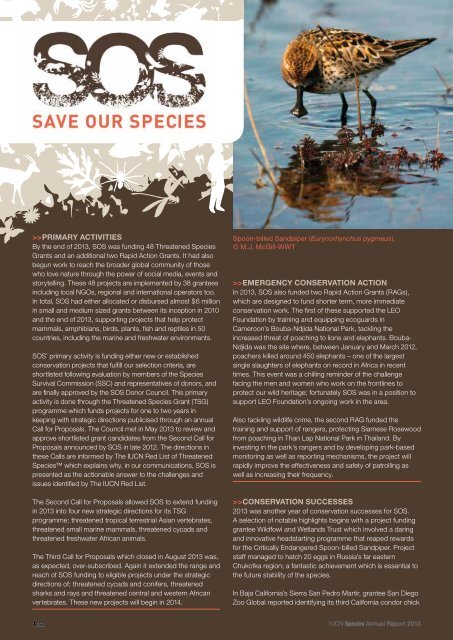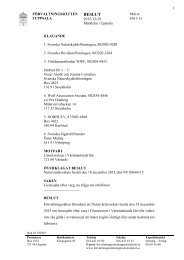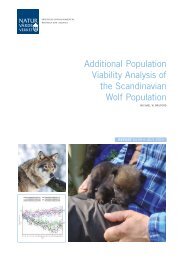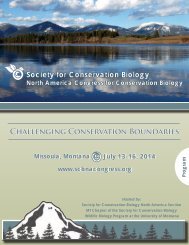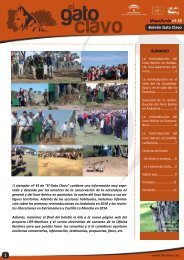1oC3Dbk
1oC3Dbk
1oC3Dbk
Create successful ePaper yourself
Turn your PDF publications into a flip-book with our unique Google optimized e-Paper software.
Primary Activities<br />
By the end of 2013, SOS was funding 48 Threatened Species<br />
Grants and an additional two Rapid Action Grants. It had also<br />
begun work to reach the broader global community of those<br />
who love nature through the power of social media, events and<br />
storytelling. These 48 projects are implemented by 38 grantees<br />
including local NGOs, regional and international operators too.<br />
In total, SOS had either allocated or disbursed almost $6 million<br />
in small and medium sized grants between its inception in 2010<br />
and the end of 2013, supporting projects that help protect<br />
mammals, amphibians, birds, plants, fish and reptiles in 50<br />
countries, including the marine and freshwater environments.<br />
SOS’ primary activity is funding either new or established<br />
conservation projects that fulfill our selection criteria, are<br />
shortlisted following evaluation by members of the Species<br />
Survival Commission (SSC) and representatives of donors, and<br />
are finally approved by the SOS Donor Council. This primary<br />
activity is done through the Threatened Species Grant (TSG)<br />
programme which funds projects for one to two years in<br />
keeping with strategic directions publicised through an annual<br />
Call for Proposals. The Council met in May 2013 to review and<br />
approve shortlisted grant candidates from the Second Call for<br />
Proposals announced by SOS in late 2012. The directions in<br />
these Calls are informed by The IUCN Red List of Threatened<br />
Species which explains why, in our communications, SOS is<br />
presented as the actionable answer to the challenges and<br />
issues identified by The IUCN Red List.<br />
The Second Call for Proposals allowed SOS to extend funding<br />
in 2013 into four new strategic directions for its TSG<br />
programme; threatened tropical terrestrial Asian vertebrates,<br />
threatened small marine mammals, threatened cycads and<br />
threatened freshwater African animals.<br />
The Third Call for Proposals which closed in August 2013 was,<br />
as expected, over-subscribed. Again it extended the range and<br />
reach of SOS funding to eligible projects under the strategic<br />
directions of; threatened cycads and conifers, threatened<br />
sharks and rays and threatened central and western African<br />
vertebrates. These new projects will begin in 2014.<br />
Spoon-billed Sandpiper (Eurynorhynchus pygmeus).<br />
© M.J. McGill-WWT<br />
>>Emergency Conservation Action<br />
In 2013, SOS also funded two Rapid Action Grants (RAGs),<br />
which are designed to fund shorter term, more immediate<br />
conservation work. The first of these supported the LEO<br />
Foundation by training and equipping ecoguards in<br />
Cameroon’s Bouba-Ndjida National Park, tackling the<br />
increased threat of poaching to lions and elephants. Bouba-<br />
Ndjida was the site where, between January and March 2012,<br />
poachers killed around 450 elephants – one of the largest<br />
single slaughters of elephants on record in Africa in recent<br />
times. This event was a chilling reminder of the challenge<br />
facing the men and women who work on the frontlines to<br />
protect our wild heritage; fortunately SOS was in a position to<br />
support LEO Foundation’s ongoing work in the area.<br />
Also tackling wildlife crime, the second RAG funded the<br />
training and support of rangers, protecting Siamese Rosewood<br />
from poaching in Than Lap National Park in Thailand. By<br />
investing in the park’s rangers and by developing park-based<br />
monitoring as well as reporting mechanisms, the project will<br />
rapidly improve the effectiveness and safety of patrolling as<br />
well as increasing their frequency.<br />
>>Conservation Successes<br />
2013 was another year of conservation successes for SOS.<br />
A selection of notable highlights begins with a project funding<br />
grantee Wildfowl and Wetlands Trust which involved a daring<br />
and innovative headstarting programme that reaped rewards<br />
for the Critically Endangered Spoon-billed Sandpiper. Project<br />
staff managed to hatch 20 eggs in Russia’s far eastern<br />
Chukotka region; a fantastic achievement which is essential to<br />
the future stability of the species.<br />
In Baja California’s Sierra San Pedro Martír, grantee San Diego<br />
Zoo Global reported identifying its third California condor chick<br />
102 IUCN species Annual Report 2013


